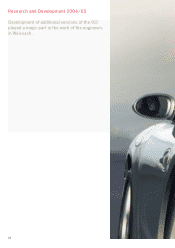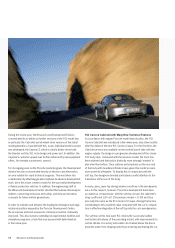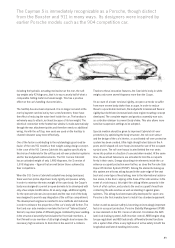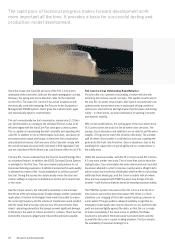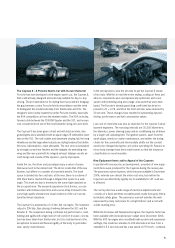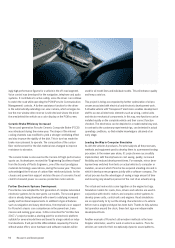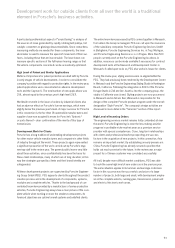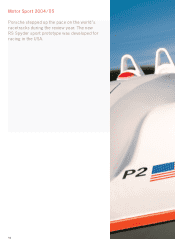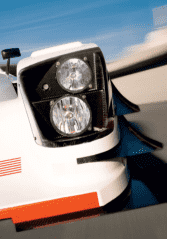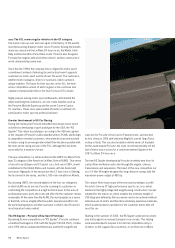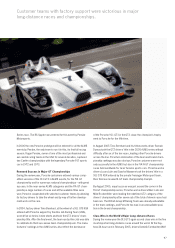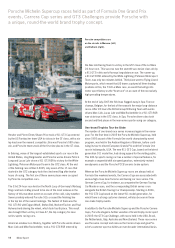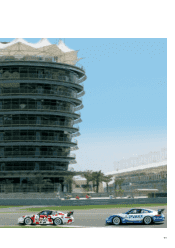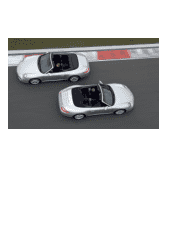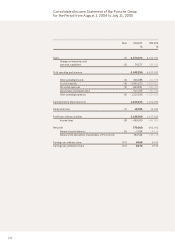Porsche 2004 Annual Report Download - page 100
Download and view the complete annual report
Please find page 100 of the 2004 Porsche annual report below. You can navigate through the pages in the report by either clicking on the pages listed below, or by using the keyword search tool below to find specific information within the annual report.
Motor Sport96
The 911 scores regular victories in the GT category.
One name crops up over and over again in the history of the world’s
most famous long-distance motor races: Porsche. Among the brand’s
many successes are the Le Mans 24-hour races, the Monte Carlo
Rally and the marathon Paris-Dakar event. Porsche also designed
Formula One engines with which three drivers’ and two constructors’
world championships were won.
Since the late 1990s the company has re-aligned its motor sport
commitment: instead of entering its own factory team it supports
customers in motor sport events all over the world. The customers,
whether team managers, drivers or sponsors, help to uphold a
unique tradition. The basis for their success is the 911, the near-
series competition version of which regular scores victories and
captures championship titles in the Gran Turismo (GT) classes.
Highly popular among motor sport enthusiasts, both behind the
wheel and lining the racetracks, are one-make trophies such as
the Porsche Michelin Supercup and the seven Carrera Cups in
15 countries. These race series enable Porsche’s customers to
participate in motor sport at professional level.
Greater Involvement in US Car Racing
During the review year Porsche extended its previous motor sport
activities by developing a sport prototype for the USA, the “RS
Spyder”. This return to prototype car racing in the USA was agreed
at the request of Porsche’s sales subsidiary there, PCNA, and its high-
ly competition-oriented customers, who wished to become involved
in motor racing to an even greater extent than has been possible with
the near-series racing version of the 911, although this has been
successful for a number of years.
The new competition car will be entered in the LMP2 (Le Mans Proto-
type 2) category of the American Le Mans Series (ALMS). This series
of races for prototypes and GT sports cars, first run in 1999, is well
established in the United States and Canada, with ten heats held
each year. Highspots of the season are the 12-hour race in Sebring,
the first event in the series, and the 1,000-mile marathon in Atlanta.
By choosing LMP2, the second-highest of the four car categories
in which ALMS races are run, Porsche is joining its customers in
confronting the competition at a high technical level. In this area of
professional motor sport, the costs and effort for the customer remain
reasonable. At the same time the ALMS, the most popular race series
in the USA, acts as a highly effective public awareness platform for
the participating teams and their sponsors in what is also Porsche’s
most important sales market.
The RS Spyder – Porsche’s New Sport Prototype
By naming its new competition car “RS Spyder”, Porsche continues
a tradition that began in 1953 with the Spyder 550 RS 1500, continu-
ed in 1954 with an unexpected third place and the first significant
class win for Porsche in the Carrera Panamericana, and reached
its first climax in 1956 with Umberto Maglioli’s overall Targa Florio
victory in Sicily. This success heralded a whole series of triumphs
for this open-topped Porsche, the most recent but possibly not the
last of which was a victory for a customer-entered Spyder in the
1997 Le Mans 24-hour race.
The new RS Spyder developed by Porsche is entirely new from its
carbon fiber and Kevlar outer skin through the engine, chassis,
transmission and suspension. The heart of this new competition car
is a 3.4-liter V8 engine designed for long-distance racing, with the
impressive power output of 480 hp.
The carbon-fiber monocoque of the new sport prototype, as with
Porsche’s Carrera GT high-performance sports car, is a central
element in the highly integrated weight-saving construction concept
adopted for the entire car, which enables the minimum weight of
750 kilograms defined by the race-series rules to be achieved without
extensive use of exotic and therefore extremely expensive materials,
which would represent a problem for the customer teams that will
race this car.
Starting in the summer of 2005, the RS Spyder underwent an exten-
sive test program on various European race circuits. This testing
work was intended to prepare it for its first competition entry in
October, on the Laguna Seca racetrack, in an American Le Mans


